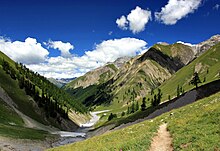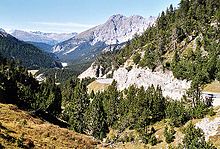|
Swiss National Park
The Swiss National Park (Romansh: Parc Naziunal Svizzer; German: Schweizerischer Nationalpark; Italian: Parco Nazionale Svizzero; French: Parc National Suisse) is located in the Western Rhaetian Alps, in eastern Switzerland. It lies within the canton of Graubünden, between Zernez, S-chanf, Scuol, and the Fuorn Pass in the Engadin valley on the border with Italy. Founded in 1914, the Swiss National Park is the oldest national park in the alps and in Central Europe. It is part of the worldwide UNESCO Biosphere Reserve[2] and has IUCN category Ia, which is the highest category, signifying a strict nature reserve. Today, the Swiss National Park has an area of 170.3 km2[3] and is the largest nature reserve in Switzerland. DescriptionThe Swiss National Park covers various terrains, from relatively low valleys to high peaks. The highest peak in the National Park is Piz Quattervals, 3165 m.a.s.l, which can be reached by an alpine hike. As of 2022, this is the only National Park in Switzerland. There are plans to create more.[4][5] An Adula National Park was planned in the Adula Alps, but in November 2016 the inhabitants voted against it.[6][7]  In the national park, it is forbidden to leave marked paths or to sleep anywhere apart from the Chamanna Cluozza, the mountain hut in the park. Due to this there are over 80 kilometers of marked hiking paths, separated into 21 individual hikes of various distances and difficulties. Dogs are not allowed, even on a leash. Due to these strict rules, the Swiss National Park is the only park in the Alps which has been categorized by the IUCN as a strict nature reserve, the highest protection level.  A visitor centre is located in Zernez. The road through the park leads over the Fuorn Pass (or Ofenpass) to South Tyrol in Italy. In addition to the Swiss National Park, there are sixteen regional nature parks in Switzerland.[8] The Swiss National Park is home to several large animals. Visitors of the park will often hear and see alpine marmots. These may even be observed from very close up in one of the many designated resting places within the park. Other large animals include ibex, red deer, chamois, red fox, golden eagles and many more. Occasionally wolves and brown bears are also observed in the park but only rarely and these animals do not permanently reside in the park any more.[9] HistoryAfter the 19th century led to a lot of the Swiss countryside being destroyed or cultivated to create space for farming in 1904 Swiss National Council Dr. Fritz E. Bühlmann[10] among others called for the creation of a nature reserve. The Swiss Federal Council created a committee to determine a suitable location for this nature reserve, and the area surrounding the Fuorn Pass was found to be best suited for this endeavour due to its remoteness from civilization and richness in flora and fauna. In 1909 supporters of the idea leased the Val Cluozza from the municipality of Zernez for 25 years. In 1913 a non-standing committee of the Federal assembly visited the Val Cluozza and afterwards supported the idea of a national park. Within the following year the region around the Fuorn Pass and the Val Minger were leased from their respective municipality and the lease of the Val Cluozza was renewed to now all last 99 years. The municipality of Zernez was increasingly supporting the idea due to the fact that the leased area had little to no agricultural potential. On the national holiday of Switzerland, 1 August 1914, the Swiss National Park was opened. Initially the costs of the lease were paid by a private company, called the Schweizerischer Bund für Naturschutz (Swiss coalition for nature protection), which today is called Pro Natura. However, when in 1913 these costs could no longer be surmounted by the private company, the Swiss Federal Government took over the costs.[11] In 1936, the Val Tavrü was removed from the Park upon request by the municipality of Scuol. In 1959, the National Park was legally restructured. A law called the Bundesbeschluss für den Nationalpark (Federal law concerning the National Park) was passed, which among other things extended the leases indefinitely and banned high voltage lines leading through the park. In 1961, the park was heavily extended once more, now totalling 166.5 km2. In 1964, zoologist Robert F. Schloeth was appointed director of the park. He would go on to serve in that post for more than 25 years while heavily influencing the parks' development. In 1968, during his tenure a new visitor centre was inaugurated in Zernez as was a Naturlernpfad (Nature learning hike) on the Fuorn pass in 1976.[12] It was during Schloeth's tenure as director that the park would become part of the UNESCO Biosphere Reserve and would be classified as a IUCN category Ia. The most recent extension of the park occurred in 2000, when 3.6 km2 the Macun Lakes and surrounding area was added to the park.[12] There was a proposition to create a less heavily regulated zone in the areas surrounding the park, which was however rejected by the public. In 2008, a new visitor centre was inaugurated in Zernez. Some of the changes in territory that the park underwent since its inception in 1909 are detailed in the table below:[13] Park rulesIn the park, visitors have to follow strict rules. These rules are regulated in a special cantonal law by the canton of Grisons and enforced by park rangers throughout the park.[14] If these rules are not followed, the park rangers may fine visitors up to 300 swiss francs.[15] Some of the rules are as follows:
Hiking routesThere are 21 numbered hiking routes in the National Park, of which 3 and 4 are alpine hikes. Hike no. 4 leads on top of Piz Quattervals (3165 m.a.s.l.), which is the highest peak in the park.
Notable peaks
GallerySee alsoReferences
External linksWikimedia Commons has media related to National parks of Switzerland.
|
||||||||||||||||||||||||||||||||||||||||||||||||||||||||||||||||||||||||||||||||||||||||||||||||||||||||||
Portal di Ensiklopedia Dunia





























